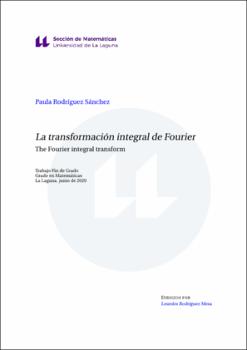La transformación integral de Fourier
Autor
Rodríguez Sánchez, PaulaFecha
2020Resumen
En esta memoria analizamos los principales aspectos relacionados con la transformación
integral de Fourier de funciones definidas en la recta real. Estudiamos algunas propiedades
básicas como el Lema de Riemann-Lebesgue, su comportamiento con respecto a algunas
operaciones fundamentales como la derivación y la convolución y la existencia de un
sistema ortonormal y completo de autofunciones para el operador integral de Fourier.
Mostramos diferentes condiciones que dan validez a la fórmula de inversión, y que, entre
otras cosas, permiten precisar el comportamiento de la transformación de Fourier sobre la
clase de Schwartz. Hacemos un análisis de la relación entre la regularidad de una función y
el decaimiento de su transformada de Fourier, incluyendo en este estudio a las funciones que
admiten una extensión holomorfa a una banda o a todo el plano complejo y establecemos el
Teorema de Paley-Wiener. Consideramos asimismo el Teorema de Plancherel para funciones
de cuadrado integrable. Entre las aplicaciones que hemos abordado se encuentran el
Principio de incertidumbre de Heisenberg y el Teorema central del límite. Asimismo, usamos
la transformación integral de Fourier como herramienta para resolver la ecuación del calor
unidimensional y el problema de Dirichlet en el semiplano. Recogemos también una
prueba de la fórmula de sumación de Poisson y la aplicamos para establecer el Teorema de
Shannon relativo a señales de banda limitada. In this work we analyze the main aspects related to the Fourier integral transformation of
functions defined on the real line. We study some basic properties such as the RiemannLebesgue Lemma, the behavior with respect to some fundamental operations as differentiation and convolution and the existence of a complete orthonormal system of eigenfunctions
for the Fourier integral operator. We show different conditions that give validity to the
inversion formula and which, amongst other things, allow us to specify the behavior of the
Fourier transform on the Schwartz class. We make an analysis of the relationship between
the regularity of a function and the decay of its Fourier transform, including in this study
the functions which extend holomorphically to a horizontal strip or to the whole complex
plane and establish the Paley-Wiener Theorem. We also consider Plancherel Theorem for
square integrable functions. As applications we have dealt with Heisenberg Uncertainty
Principle and the Central Limit Theorem. Likewise, we use the Fourier integral transform
as a tool to solve the unidimensional heat equation and the Dirichlet problem in the halfplane. We also collect a proof of the Poisson summation formula and apply it to establish
the Shannon Theorem for band limited signals.
Excepto si se señala otra cosa, la licencia del ítem se describe como Licencia Creative Commons (Reconocimiento-No comercial-Sin obras derivadas 4.0 Internacional)
Ítems relacionados
Mostrando ítems relacionados por Título, autor o materia.





